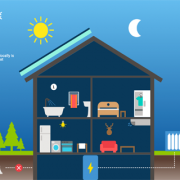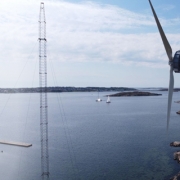MMC Editor Joe Bradbury explores sustainability with buildoffsite, who work to enable significant improvements in quality, value and productivity across all sectors of the UK construction industry.
Sustainability is a word on everybody’s lips today, featuring heavily throughout world news. Teenage environmental activist Greta Thunberg recently carried with her over a 15-day, 3,000-mile voyage across the Atlantic a powerful message; “our war on nature must end.” The 16-year-old sailed from Plymouth to New York on a zero-emissions yacht in order to minimise the carbon footprint of her travel and will be participating in UN climate summits in New York City and Chile.
If anything is to be learned from this, it is that the time for action is now.
Earth Overshoot Day, the day that humanity uses up its allowance of natural resources such as water, soil and clean air for the entire year, fell on the 29th July this year. This means that humanity is currently using nature 1.75 times faster than the Earth’s ecosystems can regenerate.
Earth Overshoot Day has crept up by two months over the past 20 years, with 2019’s date being the earliest since the world began to overshoot in the 1970s.
Regardless of your age, sex, nationality or income, this affects us all. I need to do my bit and you need to do yours. We all have a duty of care for our planet.
The construction industry alone is accountable for around 45-50% of global energy usage, nearly 50% of worldwide water usage, and around 60% of the total usage of raw materials. It also contributes to 23% of air pollution, 50% of climate change gases, 40% of drinking water pollution, and another 50% of landfill wastes.
The gravity of the situation
Over the next 100 years with 2C+ global warming locked in, the very existence of some atoll nations is threatened by rising sea-levels. Limiting warming to 1.5C may restrict sea level rise below 1 metre; yet even at 1.5C warming, regional food security risks are significant. Africa is particularly vulnerable, with significant reduction in staple crop yields in some countries. Between 1.5C-2C increase, mountains lose their glaciers meaning people will lose their water supplies. The entire Indian subcontinent will be fighting for survival. As the glaciers disappear from all but the highest peaks, their runoff will cease to power the massive rivers that deliver vital freshwater to hundreds of millions. Water shortages and famine will be the result, destabilising the entire region. The whole Greenland ice sheet would vanish within 140 years. Miami would disappear, as would most of Manhattan. Central London would be flooded. Bangkok, Bombay and Shanghai would lose most of their area.
The creation of buildings and subsequent infrastructure alters the environment in two ways – by consuming valuable resources and by contributing to pollution and landfills. A recent report by Willmott Dixon Group suggested that the construction industry alone is accountable for around 45-50% of global energy usage, nearly 50% of worldwide water usage, and around 60% of the total usage of raw materials.
The industry also contributes to 23% of air pollution, 50% of climate change gases, 40% of drinking water pollution, and another 50% of landfill wastes. Given these startling figures, how important is it that building firms concentrate more on waste reduction, recycling more and striving to construct sustainable buildings?
Needless to say, it is imperative that we assess our environmental impact, start changing our behaviours now and begin to break some of our old dirty habits.
The sustainability of offsite
In the case of construction, everybody will have a view on what constitutes sustainability. For some, it means a clampdown on all activity but that is hardly practical if we are to maintain a viable, largely urban society. Others will focus on reducing energy, avoiding waste and reducing environmental impacts. Some might look at the bigger picture in terms of not wasting capital and labour, and in ensuring that construction adds something tangible to the built environment as well as being sufficiently robust so as not to require early repair or replacement. All are legitimate viewpoints but none encompass the whole story.
So how does offsite construction stack up against these basic considerations? Well, offsite construction – or more specifically, offsite enabled construction – involves a manufacturing process. There is no more efficient system to ensure repeatability, consistency, assured quality, and performance in use of the assembly, module, or component. As with all manufacturing systems, there is the opportunity to minimise waste in all its forms, to recover and recycle materials and to maximise productivity. Traditional forms of construction involving the processing of commodity materials on disparate construction sites cannot hope to match, let alone outperform, what can be achieved in a factory environment.
But this is only part of the story. Designers adopting an offsite mind-set, and enabled by digital design tools, will be able to adopt an approach to design and construction that follows proven DfMA principles. This is how all other modern manufacturing industries operate. This approach is being increasingly used in UK construction and rather than dumbing down design, is serving to free up designers time to focus on achieving quality ambitions. Sustainability wins out in terms of right first-time design and construction saving resources and allowing a focus on design quality.
An offsite approach to construction on-site has the potential to require less labour, create fewer opportunities for abortive work and waste of materials and labour plus, of course, substantially faster construction on site. No one wants a construction project taking longer than it needs but that is precisely what happens when offsite methods are not being used.
An offsite approach to service delivery also delivers substantial environmental benefits in terms of installations that are fast to fit on-site, have been factory tested and involve minimal labour and minimal waste, and significantly will perform as the client specified. With its attributes, offsite is also better placed to deliver buildings with a low through life carbon footprint.
Taken together why would anyone seriously question the sustainability credentials of an offsite approach to construction? Yes, it is taken a long time to bring this about but the offsite wave is growing and increasingly, industry is looking to adopt offsite methods.
For almost 15 years Buildoffsite has been promoting both increased awareness of offsite solutions and has challenged the industry to continue to innovate. There is still a long way to go but with the adoption of digital tools, increased availability of offsite solutions, and a better understanding of the benefits among clients and suppliers, real progress is being made.
Come and see Buildoffsite at the Offsite Construction Show – 20/21 November at ExCel London. For more information please visit the below website.
www.buildoffsite.com














